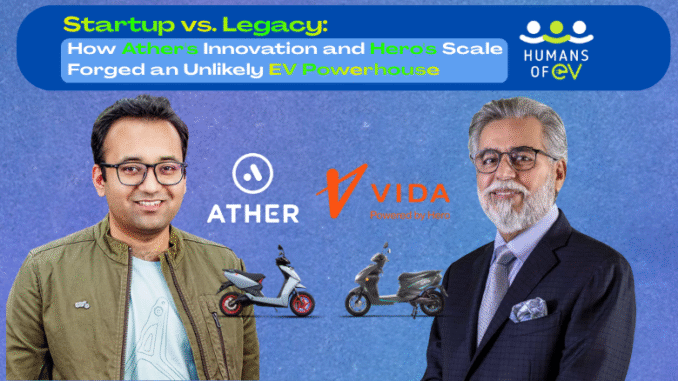
The battle for India’s electric two-wheeler market is not a simple contest. It is a complex strategic game best exemplified by the relationship between Hero MotoCorp, a legacy giant, and Ather Energy, a pioneering startup. On the surface, they are fierce rivals, with Hero’s Vida brand competing directly against Ather’s popular scooters. But beneath the surface, they are deeply linked partners, with Hero as a primary investor in Ather and both sharing a crucial piece of infrastructure: their charging network.
Two Paths to Market
Ather Energy, founded in 2013, represents the quintessential startup playbook. It built its brand from the ground up on a foundation of premium technology, sporty performance with its 450X line, and a proprietary, closed-ecosystem approach. This strategy secured a loyal, urban, tech-savvy customer base. However, its most significant recent growth has come from a pivot to the mass market with the launch of the family-oriented “Rizta” scooter, a major sales driver in 2025.
Hero MotoCorp, India’s largest two-wheeler manufacturer, took the legacy path, entering the EV space relatively late with its Vida brand in October 2022. While its initial market traction was slow, Hero is now leveraging its immense capital, vast manufacturing experience, and unparalleled dealer network to scale rapidly. The company is investing ₹1,000 crore into its EV business and saw its Vida registrations surge 248% in the first half of fiscal year 2026 (April-September 2025).
The Partnership: “Co-opetition” in Action
The dynamic between the two is defined by “co-opetition.” Hero MotoCorp is not just a competitor; it is Ather’s largest corporate shareholder. Hero has been investing in the startup since 2016 and, following a ₹124 crore investment to acquire an additional 2.2% stake, now holds approximately 40.39% of the company. This strategic investment gives Hero deep insights into the EV market and a significant financial stake in its rival’s success.
In a landmark move, the two rivals joined forces to create a unified charging ecosystem. By combining the Ather Grid and the Vida Grid, they launched an interoperable network of over 1,900 fast-charging points across 100+ cities. For Hero, this was a brilliant strategic stroke, instantly solving “range anxiety” for its new Vida customers by giving them access to the largest and most established fast-charging network in the country. For Ather, it helped establish its charging connector as a de facto standard, accelerating the development of a unified ecosystem for all players.
Market Trajectory and Sales Performance
The 2025 sales data shows both brands on a strong upward trajectory, though with different growth patterns. Hero’s Vida, starting from a lower base, has seen explosive growth, with monthly sales climbing from 1,626 in January to a peak of 15,954 in October. Ather, leveraging its new models, has maintained higher, more consistent volumes, culminating in a massive, festival-driven record of 28,158 units in October. This intense rivalry has firmly established both players in the top 5 of the market, demonstrating how their unique blend of competition and collaboration is reshaping India’s EV landscape.



